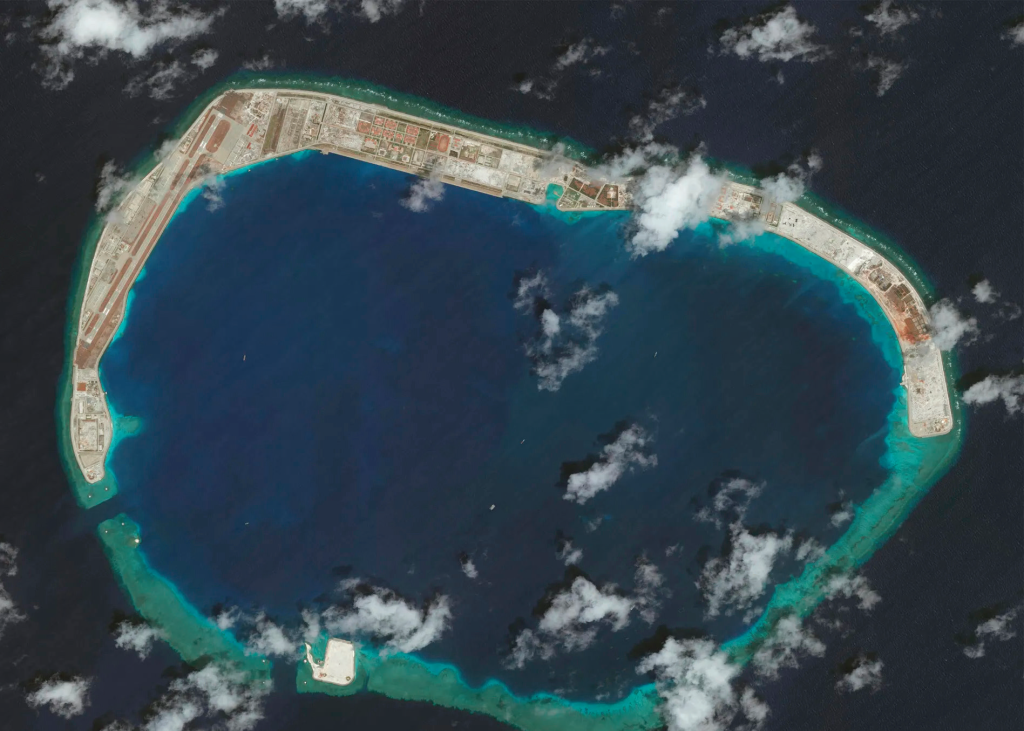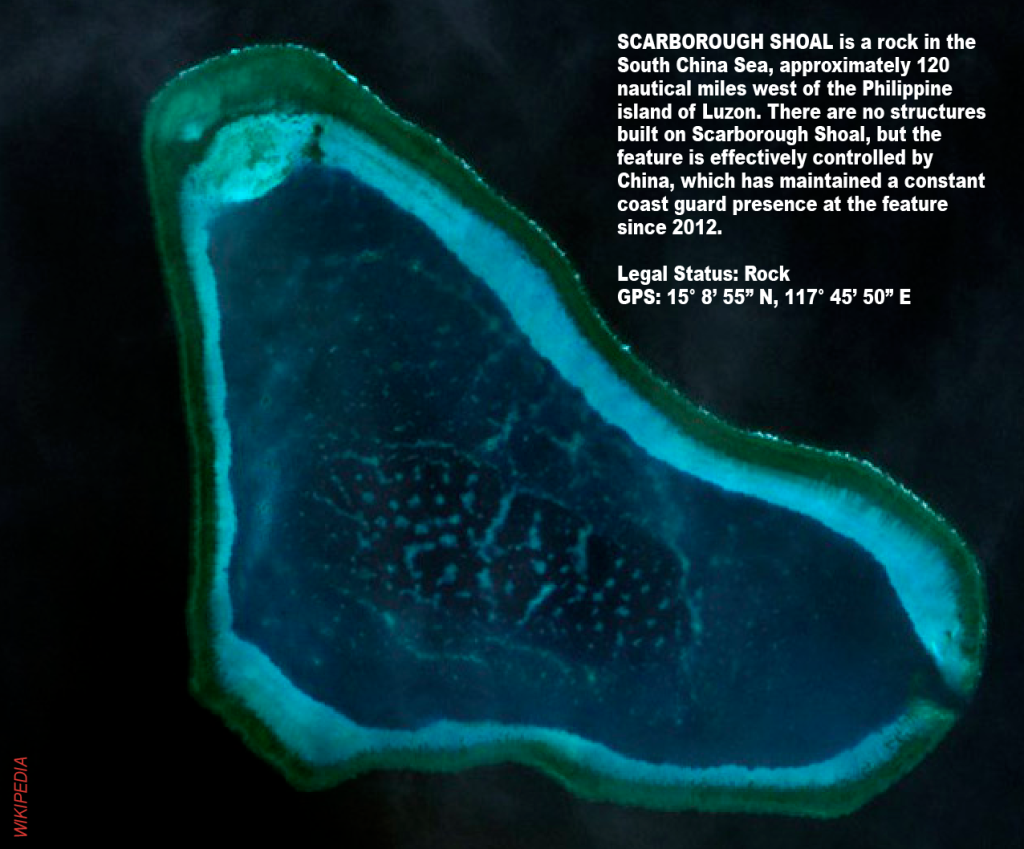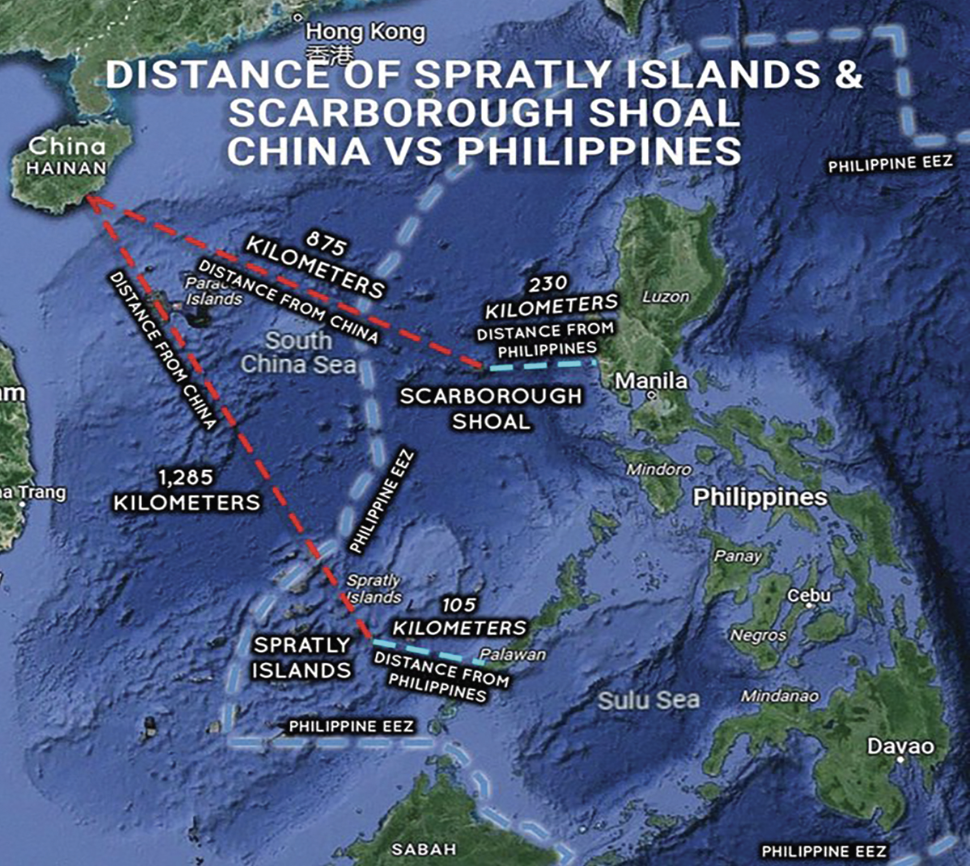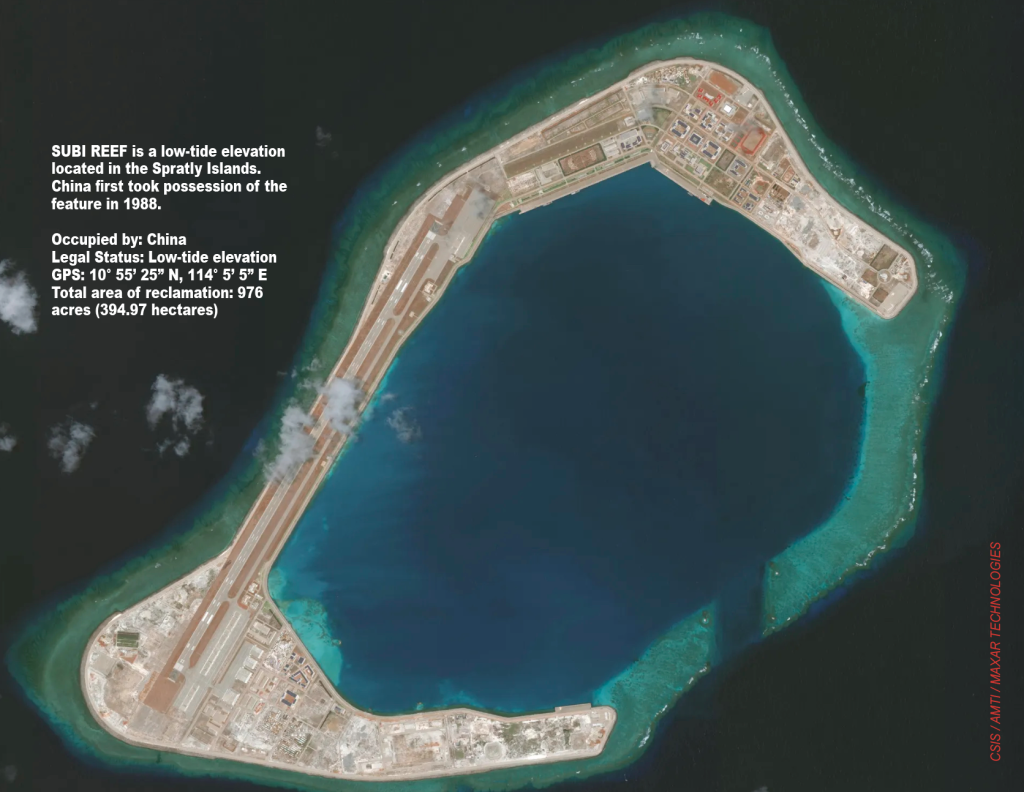By Tony Lopez

Since 1988, the Philippines and China have been quarreling over six pieces of reefs whose total land area, thanks to unbridled Chinese reclamation, today has expanded to a total of 1,253 hectares, 25% larger than the original Makati town.
Since 2012, the Philippines and China have been quarreling over a rock with an area of 15,000 hectares and a height of five feet. It is 1.5 times the size of Hacienda Luisita.

This is the Scarborough Shoal (Panatag Shoal), 230 kms from the main Philippine island of Luzon and 875 kms from mainland China. Today, it is a pain in the ass of at least three countries – the Philippines, China and the United States. It has the potential to trigger a global war.
If proximity is ownership, then Scarborough Shoal properly belongs to the Philippines. Indeed, Scarborough Shoal is part of the Philippines’ Exclusive Economic Zone (EEZ).
Under the United Nations Convention on the Law of the Sea (UNCLOS), resources above and below a formation in the seas in a country’s EEZ belong to that country, and not to any other country. China is a signatory to UNCLOS, yet it refuses to give up the Scarborough which it seized by subterfuge in 2012. China’s seizure prompted Manila to bring the issue to the International Arbitration Court at The Hague.
On July 16, 2016, the arbitral tribunal ruled overwhelmingly in favor of the Philippines and declared unlawful major elements of China’s claim – including its nine-dash line, recent land reclamation activities, and other activities in Philippine waters.
The six reefs China illegally seized in 1988 and which the Philippines also claims are: 1) Mischief Reef (or Panganiban Reef), 558 hectares today; 2) Subi Reef (Zamora Reef), 395 hectares; 3) Fiery Cross Reef (Kagitingan Reef), 274 hectares; 4) Gaven Reef (Burgos Reef), 13.75 hectares; 5) Hughes Reef (McKennan Reef), 7.68 hectares and 6) Cuarteron (Calderon Reef), 5 hectares. Their total land area: 1,353.4 hectares.
The total Philippine land area is 30 million hectares. This is the territory over which the Philippines has sovereignty, meaning full ownership, without interference by other states.

The total area seized by China from the Philippines is 16,353 hectares – 15,000 hectares of Scarborough and 1,353 hectares of the six reefs. It is an infinitesimal .0005451% of the Philippines’ 30 million hectares of sovereign territory.
This .054% is not even Philippine sovereign territory. Manila has only sovereign rights over the 16,353 hectares, meaning only the right to use and exploit the reefs or rock’s natural resources, fisheries and minerals.
The reefs and rocks do not belong to the Philippines like a titled land. Yet, the Philippines will go to war over this .054%.
Per Wikipedia, sovereignty, as applied to states, comprises “rights and power over a territory, responsibility and accountability over a population, general and specific authorities and recognition by other sovereign states;” sovereign rights under the UNCLOS “pertain to the entitlements or privileges of a state.”
The Philippines claims ownership of Scarborough Shoal using the 51×33 cm Murillo Velarde Map of 1744 which shows that an island identified as Panacot belongs to the Philippines.
China claims 90% of the South China Sea, invoking an imaginary “historic, legal title” manifested through its so-called nine-dash line.
In 2016 the Permanent Court of Arbitration debunked the Chinese claim. China had “no historical rights” based on their nine-dash line map.

China, however, has rejected the ruling and has used its naval might to enforce what it wants. China has 370 warships, the largest in the world. The fleet is expected to reach 395 ships by 2024.
Since around 2009, China has employed all kinds of tactics to enforce its claims, including using its military, coast guard, and maritime militia to harass foreign ships; exploring and extracting resources in disputed areas and, starting in 2013, constructing artificial islands and basing military and civilian assets there.
China has the world’s largest maritime militia, a quasi-military force of fishermen reporting to China’s People’s Liberation Army and trained in a variety of missions, including search and rescue, reconnaissance, deception operations, law enforcement and “rights protection,” which often entails activities like harassing foreign vessels in China’s claimed waters (Andrew Erickson and Conor M. Kennedy, “China’s Fishing Militia is a Military Force in all but Name”).
On April 11, 2024, during a Washington DC summit of three leaders (Joseph Biden, Fumio Kishida and Ferdinand Marcos Jr.), the US, Japan and the Philippines formed a Trilateral Alliance as part of America’s Pivot to Asia Strategy.
In that summit, President Biden reiterated the so-called ironclad US commitment to come to the defense of the Philippines in case of an attack on Philippine armed forces, aircraft and public vessels, including the Philippine Coast Guard in the Pacific, including anywhere in the South China Sea.
Said a senior American official: “The President’s (Biden’s) commitment to the Philippines and to President Marcos on South China Sea issues has been quite clear. He (Biden) has repeated many times that the US-Philippines Mutual Defense Treaty applies to the South China Sea, including the Philippines’ vessels that may be underway there, including its Coast Guard vessels.”
After nearly 80 years of being banned from militarizing, Japan will now become a military power, to help the US police Asia.
Tokyo has always been scared of a future Chinese invasion.
Futurely, the Coast Guard fleets of the US and Japan will help patrol the South China Sea even as Manila, Tokyo and Washington DC coordinate and monitor China’s so-called grey zone tactics, coercive tactics and what those tactics could imply.
The trilateral alliance will expand under a so-called rules-based Indo-Pacific strategy, to include US treaty partners Australia, South Korea, Thailand and regional partners India, Indonesia, Malaysia, Mongolia, New Zealand, Singapore, Taiwan, Vietnam and the Pacific Islands.
Says the New York Times:
“These collaborations highlight how the region sees China. Many countries fear Beijing’s growing military strength and belligerence — its threats against the democratic island of Taiwan, its claim to most of the South China Sea and its land grab at the border with India. They are also less sure about China as an economic partner, with the slowing pace of its post-Covid economy and tilt away from pro-growth, pro-entrepreneur policies under Xi Jinping.”
“Military budgets across Asia have soared in recent years, and the demand for American defense technology has never been higher.
“Yet many countries in the region now see themselves as players in an emerging multipolar order. “We are the main characters in our collective story,” President Ferdinand R. Marcos Jr. of the Philippines said during a keynote speech at the conference in Singapore. And as a result, they have turned to the United States less as a protector than a provider of goods (weapons), services (training) and investment (in new technology and equipment maintenance).
“Japan has made the sharpest turn. From easing tensions with South Korea to pulling back from decades of pacifism with plans to sharply increase its military budget, to signing troop movement agreements with Australia and other countries, Tokyo has made clear that it now seeks a leading role in protecting regional stability. But even as Washington welcomes the move, Tokyo’s actions grow in part from a critical assessment of the United States.”
Wonders the NYT:
“There is a lot of ambiguity in the coalitions that increasingly define American power in Asia. How would the region respond if the Philippines stumbled toward a violent clash in the South China Sea? Or in a war over Taiwan — a center of the global chip business that China sees as its own lost territory — would the countries co-developing military equipment with the United States, or welcoming longer runways, actually spring into action?”
